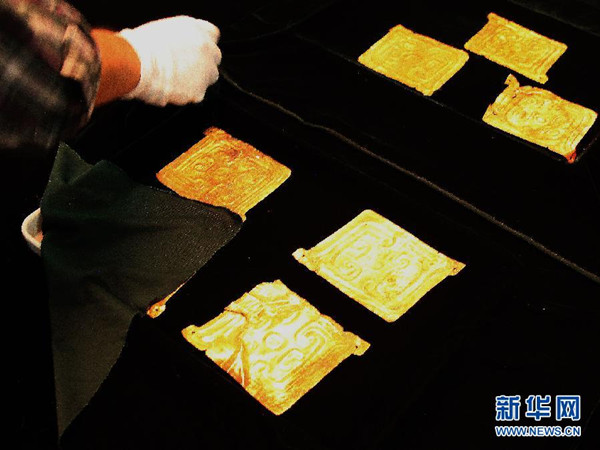
Twenty-four solid gold ornaments dating back almost 2,000 years were returned to China without compensation on Monday, on the grounds that they had been looted from tombs in Gansu province and held by French collectors. Following a similar action this summer, a total 56 priceless relics have returned home in two months.
Christian Deydier, a noted French collector and holder of most of the gold items, attended the hand-over ceremony with Xia Hongmin, vice governor of the province, at Gansu Provincial Museum. According to the State Administration of Cultural Heritage, the relics will be permanently stored and displayed in the provincial museum.
The gold relics came from tombs in Dabuzishan in Lixian County, Gansu Province. The tombs belonged to residents of Qin, one of the small kingdoms during the Spring and Autumn period (770 BC-476 BC) of Chinese history. In 221 BC, the king of Qin united China's kingdoms, founded the Qin Dynasty and became the country's first emperor.
Deydier and another French collector, Francois Pinault, returned 32 artifacts from the same tombs in July, the first time cultural relics have been successfully returned to China following bilateral negotiations between the Chinese and French governments.
While attending an exhibition on the tombs, Deydier said he hoped all Dabuzishan artifacts lost in foreign countries could soon "return home and be united".
"When I saw the Dabuzishan gold relics in 1993 for the first time, by my own judgment, they should be valuable, although my European counterparts didn’t agree with me at all. I invited my Chinese friends to France, and they confirmed my viewpoint after careful observation. In the international antiquities black market, people resmelt the gold decorations and sell them. So I've talked with officials in China's State Administration of Cultural Heritage, and told them I planed to collect the Dabuzishan relics lost in Japan as soon as possible. I wish to bring all of them here on my next trip to China," Deydier said.
Xia, on behalf of the provincial government, thanked Deydier for his two generous acts. He stressed that the return of Chinese relics shows the remarkable results of Chinese diplomacy. He also confirmed that the special exhibition of the first batch of returned gold relics was highly praised both in the country and abroad.
According to local media in Gansu province, the 24 newly returned relics reveal a "high gold content" (93 percent on average) and are made in a similar artistic style but are different in size. The large ornaments are about 15 centimeters long and the smaller one are only five centiments long. There are also Ruyi (a symbol of good luck in ancient China) patterns carved on their surfaces.
Tombs in Dabuzhishan were badly looted during the 1990s and a large number of relics, including the gold ornaments, were smuggled abroad. The gold ornaments may have been used to decorate coffins or for horse armor.
The relics were in the Guimet Museum in Paris, having been donated by Pinault and Deydier, when China approached France for their return in 2014. French law forbids national museums giving away their collections.
Through careful negotiation, however, the two sides found a way out. The donations were withdrawn and the artifacts were returned to their previous private owners, removing the legal barrier to getting them back to China.
China has been campaigning for the return of a large number of its cultural relics, many of which were looted from tombs or royal palaces and are held by foreign museums and private collectors.
Earlier this year, a 1,000-year-old Buddha statue, with a mummified monk inside, was pulled from a Hungarian exhibition following allegations that it was stolen from a Fujian village. Its Dutch owner said he was willing to give it back to the village if it is proved to have been stolen from there.





